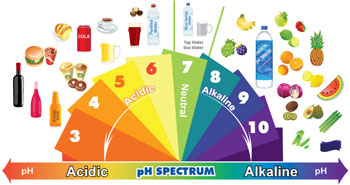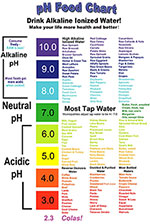By Dr. Jeff - October 21, 2014

You’ve probably heard the term pH or something about acid and alkaline foods if you spend any time exploring nutritional information. It’s become a much more popular topic in the recent years, and for good reason. The acid-alkaline balance in the body is so important that it can literally have a life or death impact – not to get all serious, but keeping your pH in good shape is very important to your good health and especially to overcoming disease.
Ok, here are the basics about pH. I call it pH 101 in my talks, but don’t fret, I’ll keep it simple. The term pH stands for ‘potential hydrogen’ and refers to the hydrogen ion concentration of a substance, and that determines how acid or alkaline that substance is. The pH scale ranges from 0 to 14 with 7 considered neutral. The lower the number, the stronger of an acid it is, and the higher the number makes it more alkaline. Here are some examples of acidic solutions: battery acid has a pH of 1.5 – pretty strong, phosphoric acid in pop is 2.5, apple cider vinegar is about 3-4, and coffee is 5.5. Water is considered neutral at 7, but most drinking water is usually slightly acidic, around 6.5 – 6.9. On the alkaline side is baking soda at 8.2, soap is about 10, bleach is 12 and Drano is 13 – very caustic.
Just about everything in the physical world is affected or controlled by pH, and in the world of biology, it’s certainly very critical. In the human body there are many different, but closely maintained pH levels. For instance skin and the bowels are slightly acidic, while the mouth and the majority of the small intestine are alkaline. The most extreme is the stomach which should be very acidic, around 1 – 1.5, however, most peoples’ stomachs do not have enough acid, causing the number one symptom worldwide – heart burn. I know that may sound wrong, but see my article on the importance of stomach acid.
The most critical pH is that of the blood which is strictly regulated at 7.35 – 7.45. If your blood pH goes outside of that range, disease will ensue and you will likely not be feeling well. If it’s chronically out of range, you are probably in the hospital and if it goes below 6.8 or above 7.8, you’re dead. So you can understand that things that influence the pH of your blood can either support your health or cause very serious problems.
Your body is on a constant mission to maintain a tight regulation of the pH of your blood. And while there are many environmental stressors, like toxic chemicals and pollutants, the greatest burden that our body is constantly compensating for is the foods we eat. And not to generalize, but let’s face it, even with the best intentions, we’re surrounded by poor foods. The foods of the standard American diet (SAD) are predominantly full of sugars, unhealthy fats, processed foods (I favor the term industrial by-products), and factory farmed animal meats. All of which take a heavy toll on the digestive system, but in this case they stress the pH of the blood, and thus effect every organ system of the body.
With poor diets, our bodies have to do a lot of compensating to keep the blood’s pH in balance and we do that mostly with minerals which have a remarkable alkalizing effect. Your body will sacrifice calcium and potassium from bones and teeth, iodine from the thyroid, and magnesium from muscles and nerves all at the expense of other bodily needs just to keep the blood pH balanced and you alive. Considering that most people start out in a state of mineral deficiency, add to that a diet that stresses the blood and it’s easy to understand how we suffer from chronic disease.
So how do the foods we eat effect our pH? Foods can be categorized into two groups; acid forming foods and alkaline forming foods. Notice the word ‘forming’, which means when the foods are digested and get processed in the gut and liver, and passed to the blood, they then impart an acid or alkaline effect in the blood. In their raw or original state (going into the mouth), most all foods are on the acid side, and a few slightly alkaline, somewhere between a pH of 2 – 7.5. A lemon or tomato for instance are very acidic in the raw state, but impart a very alkaline pH in the blood.
The goal of healthy eating, reducing disease and even eliminating cancer [see this video by Dr. Leonard Coldwell], is to consume a diet that is comprised predominantly of alkaline forming foods. A good start would be a balance of 60% alkaline to 40% acid forming foods. An excellent balance would be an 80:20 ratio, especially when dealing with disease. But, this is the part that most people don’t really want to hear, however it’s really important, so listen up. Most all acid forming foods are part of the SAD; breads, dairy, sugar, meats, pizza, processed foods, ice cream and strongest acid former of all is soda. The alkaline forming foods are basically most all plants. Click on this graphic for a full size view.
Good alkaline forming foods are raw vegetables, especially cruciferous types, spinach, onions, tomatoes and even lemons and limes. Most fruits are good also, but not as strong of an alkaline effect. And if you want an easy way to add to the alkaline side, drink alkaline water – put a capful of baking soda in a gallon of filtered tap water for your daily water supply.
Remember, pain and inflammation, digestive disorders, skin problems, headaches, chronic infections and fungus, disease and cancer, all FEED on the SAD. But the life of your cells and the healing of tissues all thrive in an alkaline state. And here’s an important fact (what you can hear in Dr. Coldwell's video): In an alkaline and oxygenated state, cancer cell growth stops.
Do what you can to transition toward a plant based diet, cut out as much processed and sugar-laden foods as you can and strive for some daily exercise. Even 15 minutes will do a lot to add some needed oxygen to the tissues. For an optimal nutritional evaluation, give me a call and let me help you get on the right track!
I know that eating well is challenging, especially in today's times. Don’t get overwhelmed, but understand that while most common foods in our country are stressful, it’s the understanding of what foods do and how your body uses them that enables you to make a positive change. Hopefully this provides useful information to empower your efforts for a healthy lifestyle.
